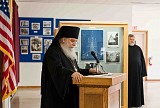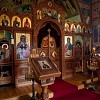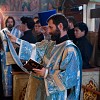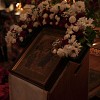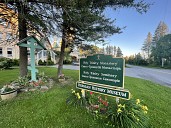Holy Trinity Monastery added to the National Register of Historic Places
Holy Trinity Monastery added to the National Register of Historic Places
On December 3rd, 2011, in the early afternoon people from all walks of life gathered together at the seminary hall at Holy Trinity Monastery to celebrate a moment of history. During a small ceremony, Archimandrite Luke, the abbot of Holy Trinity Monastery, was presented a certificate commemorating the monastery’s addition to the National Register of Historic Places. The monastery was added to the National Register on July 15., 2011.
It was the culmination of over four years of work by the monastery, local preservation groups, including the Preservation League of New York State and Otsego 2000, the New York State Historic Preservation Office and the Mohawk Valley Heritage Corridor Commission
To qualify for the National Register, a historic place must meet one of four primary criteria, in this case, the monastery’s unique architecture, design and construction, as well as the role it played in 20th century world history.
“Properties owned by religious institutions or used for religious institutions or used for religious purposes are not ordinarily considered eligible for National Registry status, however there are exceptions,” said Protodeacon Victor Lochmatow in a news release. The monastery qualified, he said, because the Byzantine-style architecture of the buildings has its own importance.
In the 20th century, the monastery was a gathering place for people who had lost their homes and country during the Soviet communist era. The monastery became a 'little bit of Russia' for immigrants forced to leave their homeland, where they were able to preserve their culture and religion. The monastery's role as a distribuor of spiritual literature which found its way behind the iron curtain, contributed to the recognition of its historic significance.
Receiving the status is significant because the church is now eligible for federal grant money and investment tax credits on rehabilitation work.
Tania Werbizky, regional director of the Preservation League of New York State, called Holy Trinity Monastery “one of the state’s most important landmarks.” In 2008, the Preservation League of New York State placed the monastery on its “Seven to Save” list of endangered properties. “We took this action not only because the property faced threats from unsympathetic, industrial-scale development proposed nearby, but also because we were certain of its extraordinary significance,” Werbizky said.
The proposal of a wind farm nearby threatened the serenity of the monastery Murianka said, adding that the noise, shadows and industrial feeling of the wind farm would be particularly harmful to the 10,000 visitors who come to the monastery each year. “They come to the monastery for spiritual refreshment in the context of the country,” Murianka said. Fred Miller, former executive director of the Mohawk Valley Heritage Corridor Commission, and Assemblyman Marc Butler also spoke at the ceremony. “In closing, let me suggest that we stay vigilant and aware of the treasure that is Holy Trinity Monastery,” Miller said. “Today’s celebration should be a beginning, not an ending.”
People from local, state and national government were present, as were historians, friends and neighbors. It was a joyous occasion, followed by refreshments and a guided tour of the cathedral.
Holy Trinity Monastery continues to be a gathering place for people from all continents. People still come to share in the culture and the spiritual treasure of Orthodoxy. It is a place were people bring their families to enjoy the peaceful landscape and quiet countryside, and for a brief time to share in the monastic life of the brotherhood.
It was the culmination of over four years of work by the monastery, local preservation groups, including the Preservation League of New York State and Otsego 2000, the New York State Historic Preservation Office and the Mohawk Valley Heritage Corridor Commission
To qualify for the National Register, a historic place must meet one of four primary criteria, in this case, the monastery’s unique architecture, design and construction, as well as the role it played in 20th century world history.
“Properties owned by religious institutions or used for religious institutions or used for religious purposes are not ordinarily considered eligible for National Registry status, however there are exceptions,” said Protodeacon Victor Lochmatow in a news release. The monastery qualified, he said, because the Byzantine-style architecture of the buildings has its own importance.
In the 20th century, the monastery was a gathering place for people who had lost their homes and country during the Soviet communist era. The monastery became a 'little bit of Russia' for immigrants forced to leave their homeland, where they were able to preserve their culture and religion. The monastery's role as a distribuor of spiritual literature which found its way behind the iron curtain, contributed to the recognition of its historic significance.
Receiving the status is significant because the church is now eligible for federal grant money and investment tax credits on rehabilitation work.
Tania Werbizky, regional director of the Preservation League of New York State, called Holy Trinity Monastery “one of the state’s most important landmarks.” In 2008, the Preservation League of New York State placed the monastery on its “Seven to Save” list of endangered properties. “We took this action not only because the property faced threats from unsympathetic, industrial-scale development proposed nearby, but also because we were certain of its extraordinary significance,” Werbizky said.
The proposal of a wind farm nearby threatened the serenity of the monastery Murianka said, adding that the noise, shadows and industrial feeling of the wind farm would be particularly harmful to the 10,000 visitors who come to the monastery each year. “They come to the monastery for spiritual refreshment in the context of the country,” Murianka said. Fred Miller, former executive director of the Mohawk Valley Heritage Corridor Commission, and Assemblyman Marc Butler also spoke at the ceremony. “In closing, let me suggest that we stay vigilant and aware of the treasure that is Holy Trinity Monastery,” Miller said. “Today’s celebration should be a beginning, not an ending.”
People from local, state and national government were present, as were historians, friends and neighbors. It was a joyous occasion, followed by refreshments and a guided tour of the cathedral.
Holy Trinity Monastery continues to be a gathering place for people from all continents. People still come to share in the culture and the spiritual treasure of Orthodoxy. It is a place were people bring their families to enjoy the peaceful landscape and quiet countryside, and for a brief time to share in the monastic life of the brotherhood.
Speeches
Archimandrite Luke's Speech
Fred Miller's Speech
Tania Werbizky's Speech
Nicole Dillingham's Speech
More speeches will be posted soon
Fred Miller's Speech
Tania Werbizky's Speech
Nicole Dillingham's Speech
More speeches will be posted soon
Share This:
|
| |||||||||||||
Latest News


